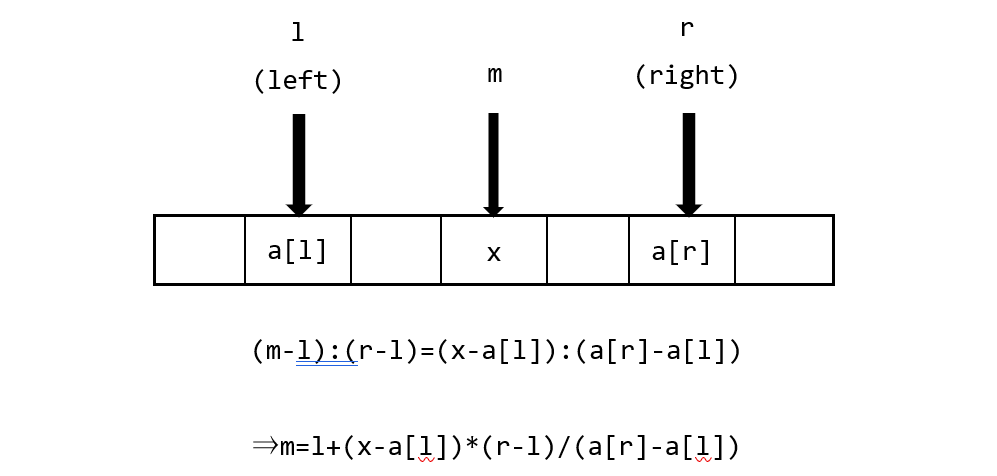探索とは
データ列の中に要素$x$があるか探すこと
特に、リスト探索はデータ列(リスト)から何らかのキーを持つ要素を見つけることが目的
線形探索
線形探索とは
リストの各要素を見て、要素$x$があるか探す。
サンプルコード
# include<stdio.h>
/* 線形探索(ソートされていなくても使える)*/
int liner_search (int list[], int list_size, int x) {
int i = 0;
while (i < list_size) {
if (list[i] == x) { return i; }
i++;
}
return -1;
}
/* 線形探索(ソート済みの時使える)*/
int sorted_liner_search (int list[], int list_size, int x) {
int i = 0;
while (i < list_size) {
if (list[i] == x) { return i; }
if (list[i] > x) { break; } // これ以降にxがある可能性はないので打ち切り
i++;
}
return -1;
}
int main (void) {
int list[10] = {0, 4, 9, 10, 13, 17, 25, 36, 37, 40};
int x;
int answer;
printf("x?> ");
scanf("%d", &x);
answer = liner_search(list, 10, x);
if (answer != -1) { printf("%d\n", answer); }
else { printf("not exist\n"); }
printf("x?> ");
scanf("%d", &x);
answer = sorted_liner_search(list, 10, x);
if (answer != -1) { printf("%d\n", answer); }
else { printf("Not exist\n"); }
}
実行結果
x?> 5
not exist
x?> 4
1
サンプルではlistはソート済みの配列なので、sorted_liner_search()もつかえる。
性能
- 時間計算量$O(n)$
- 比較回数
- 探索不成功:$N+1$回
- 探索成功:平均$N/2$回
- 整列済みの場合、sorted_liner_search()を用いると、探索が不成功の時でも平均$N/2$回の比較で済む
二分探索
二分探索とは
整列済みのデータを二分し、要素$x$がある可能性のある部分データをまた二分し、という操作を繰り返す
例えば、整数が並んでいるデータ列の中から10を見つける場合、データ列の真ん中が5だったら後半を探し、データ列の真ん中が20だったら前半を探し$\cdots$という感じ
サンプルコード
# include<stdio.h>
/* 二分探索 */
int binary_search (int list[], int list_size, int x) {
int left, right, mid;
left = 0;
right = list_size - 1;
while (left <= right) {
mid = (left + right)/2;
if (list[mid] == x) { return mid; }
else if (list[mid] < x) { left = mid + 1; }
else { right = mid - 1; }
}
return -1;
}
int main (void) {
int list[10] = {0, 4, 9, 10, 13, 17, 25, 36, 37, 40};
int x;
int answer;
printf("x?> ");
scanf("%d", &x);
answer = binary_search(list, 10, x);
if (answer != -1) { printf("%d\n", answer); }
else { printf("not exist\n"); }
}
実行結果
$ ./binary_search
x?> 9
2
$ ./binary_search
x?> 78
not exist
性能
- 時間計算量$O(\log_2n)$
- 比較回数$\log_2(n+1)$以下
- 比較回数の上限$C_n=C_{n/2}+1$
内挿探索
内挿探索とは
データが整列済みで一様に分布しているとすると、単純に「真ん中」よりも内挿した位置を見るほうが効率がいい
電話帳で「阿部さん」を探す時は、真ん中ではなく、先頭の方を見るのとおんなじ
データが一様に分布しているとすると、データ列の番号(配列の添え字)とデータの値(配列の中身)は大体比例するので、区間$[l,m]$と$[m,r]$の比を考えて、$a[m]\fallingdotseq x$となる$m$を選ぶ。
サンプルコード
注意:次のコードはxの値がlist[0]とlist[10]の範囲に入っていることが前提
# include<stdio.h>
/* 内挿探索 */
int interpolation_search (int list[], int list_size, int x) {
int left, right, mid;
left = 0;
right = list_size - 1;
while (left <= right) {
if (left == right) { mid = left; }
else { mid = left + (x - list[left])*(right - left)/(list[right] - list[left]); }
if (list[mid] == x) { return mid; }
else if (list[mid] < x) { left = mid + 1; }
else { right = mid - 1; }
}
return -1;
}
int main (void) {
int list[10] = {0, 4, 9, 10, 13, 17, 25, 36, 37, 40};
int x;
int answer;
printf("x?> ");
scanf("%d", &x);
answer = interpolation_search(list, 10, x);
if (answer != -1) { printf("%d\n", answer); }
else { printf("not exist\n"); }
}
実行結果
$ a.exe
x?> 5
not exist
$ a.exe
x?> 25
6
性能
データが一様分布なら理論上は二分探索よりも高速だが、$m$を求める計算コストが高いので、実際には要素数$n$がかなり大きくない限り二分探索より遅くなることが多い。
